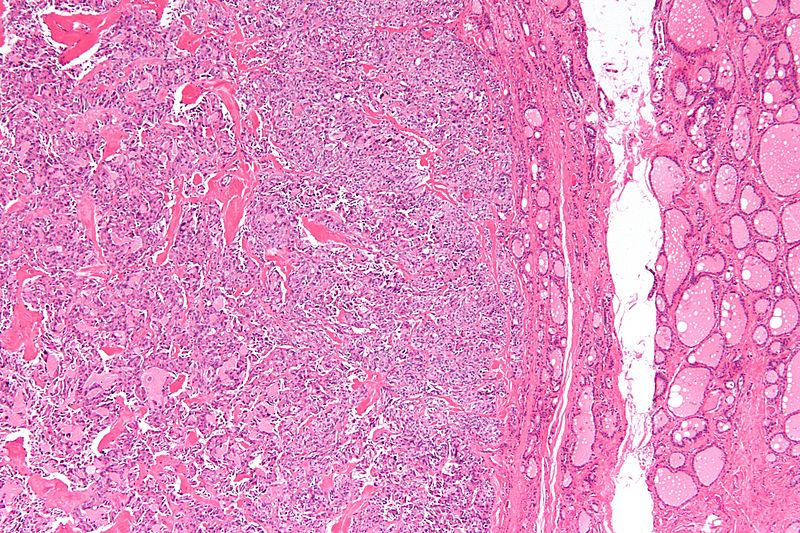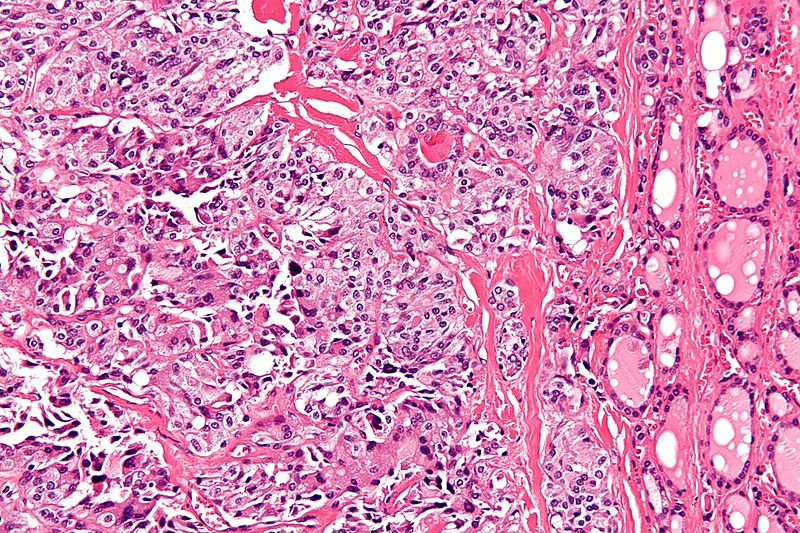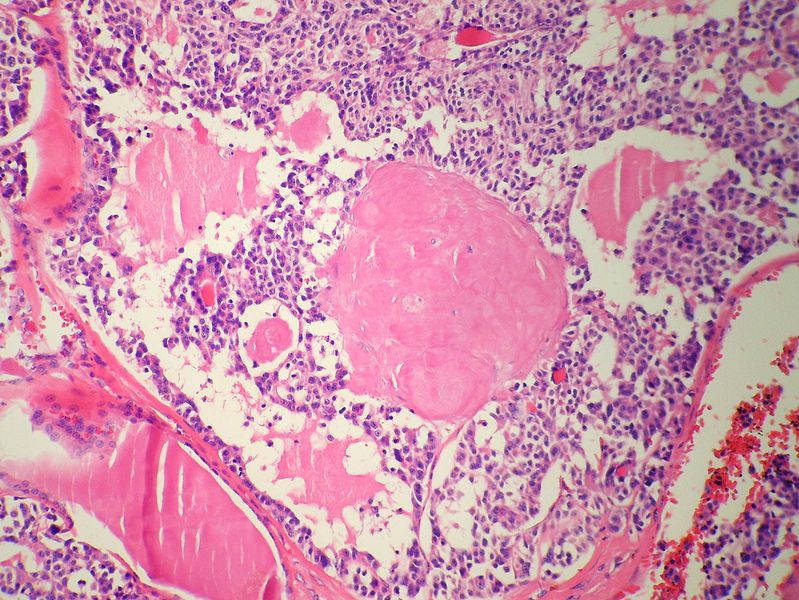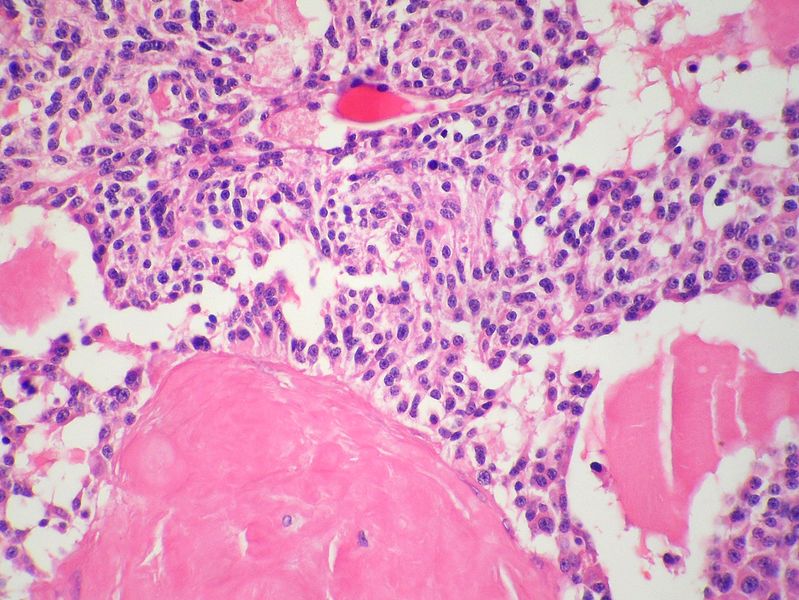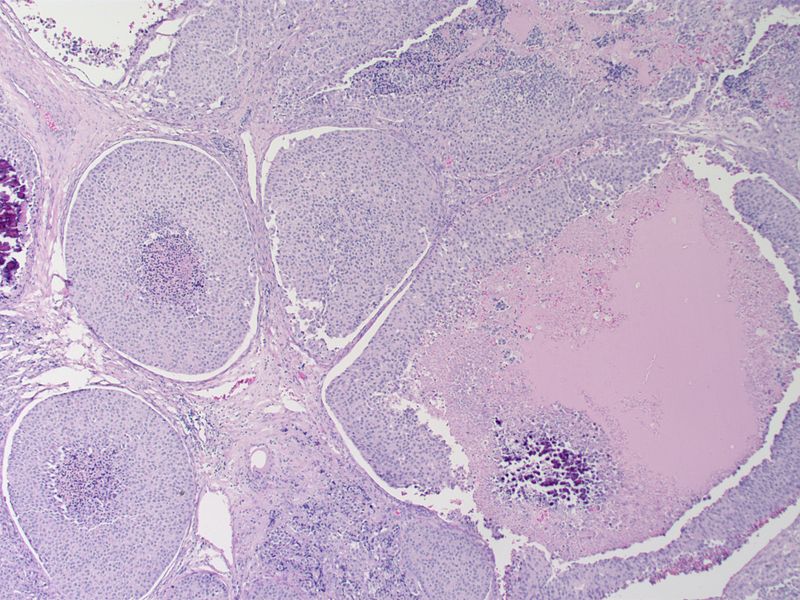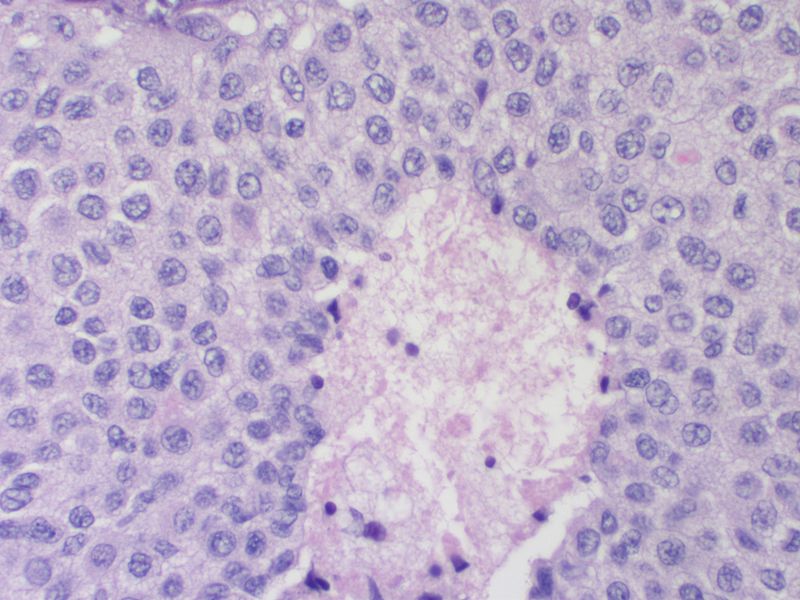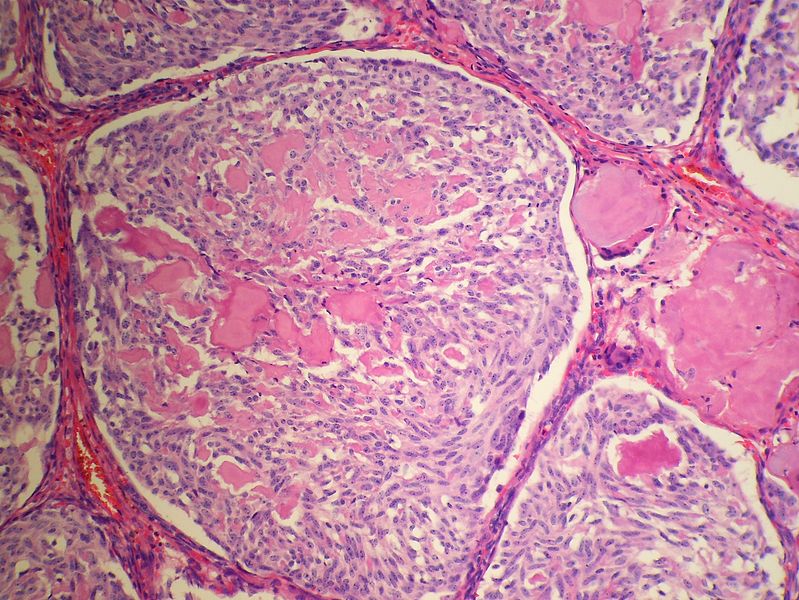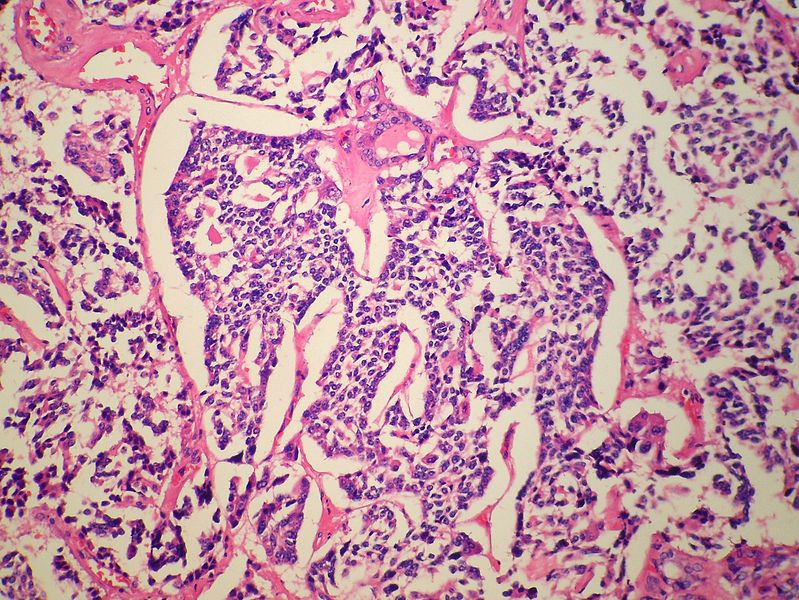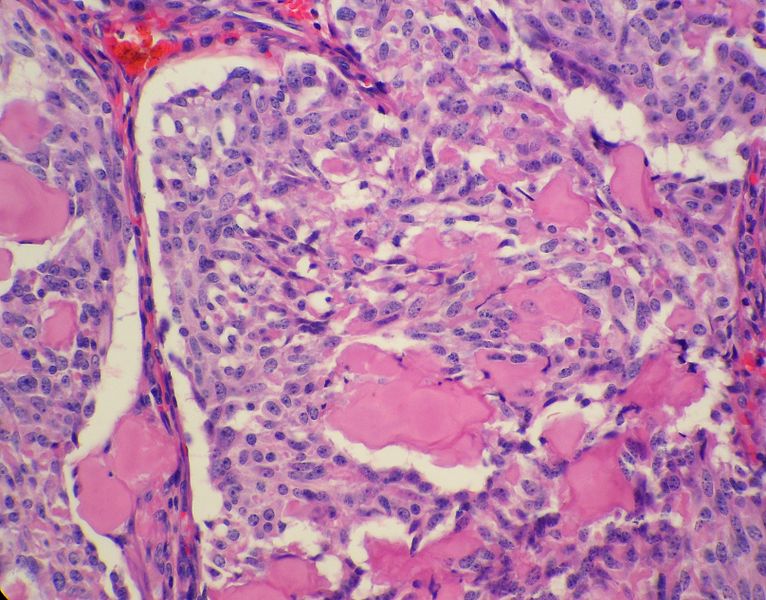Medullary thyroid cancer pathophysiology
|
Medullary thyroid cancer Microchapters |
|
Differentiating Medullary thyroid cancer from other Diseases |
|---|
|
Diagnosis |
|
Treatment |
|
Case Studies |
|
Medullary thyroid cancer pathophysiology On the Web |
|
American Roentgen Ray Society Images of Medullary thyroid cancer pathophysiology |
|
Risk calculators and risk factors for Medullary thyroid cancer pathophysiology |
Editor-In-Chief: C. Michael Gibson, M.S., M.D. [1]; Associate Editor(s)-in-Chief: Ammu Susheela, M.D. [2]
Overview
Development of medullary thyroid cancer is the result of genetic mutation of RET proto-oncogene. On gross pathology, well-circumscribed, gray, white, or yellow-colored masses are characteristic findings of medullary thyroid cancer. On microscopic histopathological analysis, polygonal to the spindle to small cells, interstitial edema, and vascular hyalinized stroma are characteristic findings of medullary thyroid cancer.
Pathogenesis
- Medullary thyroid cancer is a form of thyroid carcinoma which originates from the parafollicular cells (C cells), which produce the hormone calcitonin.[1]
- Medullary thyroid cancer may be sporadic or hereditary as part of MEN type 2 A and B.[2][3]
- Sporadic form accounts for 80% of the cases.
- Medullary tumors are the third most common of all thyroid cancers.
- Medullary thyroid carcinoma is a subtype of thyroid cancer which accounts for 5-10% of all thyroid malignancies.
- It is characterized by consistent production of a hormonal marker called calcitonin.
- Medullary thyroid carcinoma is also characterized by calcification of both primary and metastatic sites. Metastatic involvement may be seen in up to 50% at the time of presentation.
- Approximately 25% of reported cases of medullary thyroid carcinoma are familial. Familial medullary thyroid carcinoma syndromes include multiple endocrine neoplasia type 2A, multiple endocrine neoplasia type 2B, and familial non-multiple endocrine neoplasia syndromes. Medullary thyroid carcinoma can secrete calcitonin and other peptide substances. Familial medullary thyroid carcinoma which constitute approximately 25% of medullary thyroid cancer is genetic in nature, caused by a mutation in the RET proto-oncogene. When medullary thyroid carcinoma occurs by itself it is termed sporadic medullary thyroid carcinoma.
- Medullary carcinoma usually presents as a hard mass and is often accompanied by blood vessel invasion. Medullary thyroid cancer occurs in two forms, sporadic and familial. In the sporadic form, the tumor is usually unilateral. In the familial form, the tumor is almost always bilateral. In addition, the familial form may be associated with benign or malignant tumors of other endocrine organs, commonly referred to as the multiple endocrine neoplasia syndromes.
- In these syndromes, there is an association with pheochromocytoma of the adrenal gland and parathyroid hyperplasia. Medullary carcinoma usually secretes calcitonin, a hormonal marker for the tumor, and may be detectable in blood even when the tumor is clinically occult. Metastases to regional lymph nodes are found in about 50% of cases. Prognosis depends on extent of disease at presentation, presence or absence of regional lymph node metastases, and completeness of the surgical resection.
- Family members should be screened for calcitonin elevation to identify individuals who are at risk of developing familial medullary thyroid cancer. Multiple endocrine neoplasia 2A gene carrier status can be more accurately determined by analysis of mutations in the RET gene. All patients with medullary carcinoma of the thyroid (whether familial or sporadic) should be tested for RET mutations, and, if they are positive, family members should also be tested. Family members who are gene carriers should undergo prophylactic thyroidectomy at an early age.
Genetics
- Mutations in the RET proto-oncogene (REarranged during Transfection), located on chromosome 10, lead to the expression of a mutated receptor tyrosine kinase protein. RET proto-oncogene is involved in the regulation of cell growth and development and its germline mutation is responsible for nearly all cases of hereditary or familial medullary thyroid carcinoma. Germline mutation of RET may also be responsible for the development of hyperparathyroidism and pheochromocytoma. Hereditary medullary thyroid cancer is inherited as an autosomal dominant trait, meaning that each child of an affected parent has a 50% probability of inheriting the mutant RET from the affected parent. DNA analysis makes it possible to identify children who carry the mutant gene. Hereditary medullary thyroid carcinoma or multiple endocrine neoplasia (MEN2) accounts for approximately 25% of all medullary thyroid carcinomas.
- Seventy-five percent of medullary thyroid carcinoma occurs in individuals without an identifiable family history and is assigned the term "sporadic". Individuals who develop sporadic medullary thyroid carcinoma tend to be older and have more extensive disease at the time of initial presentation than those with a family history (screening is likely to be initiated at an early age in the hereditary form). Approximately 25-60% of sporadic medullary thyroid carcinomas have a somatic mutation (one that occurs within a single "parafollicular" cell) of the RET.
Associated Conditions
Gross Pathology
- Medullary thyroid cancer is usually a well circumscribed, gray, white, or yellow colored mass which is gritty to firm in consistency.
Microscopic Pathology
- Microscopic features of medullary thyroid cancer is as follows:
Cytoplasm and Nuclei
- Nested with delicate vascular septa
- Trabecular cells
- Tubular/glandular, pseudo-papillary cells
- Polygonal to spindle to small cells
- Amphophilic, somewhat granular cytoplasm
- Interstitial edema
- Stroma may have amyloid deposits with fluffy appearing acellular eosinophilic material in the cytoplasm
- Stroma is vascular and can show hemorrhage, hyalinised collagen, oedema or metaplastic bone
- Coarse calcification and psammoma bodies may be present
- Nuclei with neuroendocrine features
- Small, round nuclei.
- Coarse chromatin (salt and pepper nuclei)
Surrounding Thyroid
- +/- C-cell hyperplasia - seen with familial forms of medullary thyroid carcinoma
- C cells (AKA parafollicular cell): abundant cytoplasm - clear/pale
References
- ↑ Hu MI, Vassilopoulou-Sellin R, Lustig R, Lamont JP. "Thyroid and Parathyroid Cancers" in Pazdur R, Wagman LD, Camphausen KA, Hoskins WJ (Eds) Cancer Management: A Multidisciplinary Approach. 11 ed. 2008.
- ↑ Wells, Samuel A.; Asa, Sylvia L.; Dralle, Henning; Elisei, Rossella; Evans, Douglas B.; Gagel, Robert F.; Lee, Nancy; Machens, Andreas; Moley, Jeffrey F.; Pacini, Furio; Raue, Friedhelm; Frank-Raue, Karin; Robinson, Bruce; Rosenthal, M. Sara; Santoro, Massimo; Schlumberger, Martin; Shah, Manisha; Waguespack, Steven G. (2015). "Revised American Thyroid Association Guidelines for the Management of Medullary Thyroid Carcinoma". Thyroid. 25 (6): 567–610. doi:10.1089/thy.2014.0335. ISSN 1050-7256.
- ↑ Gertner ME, Kebebew E (August 2004). "Multiple endocrine neoplasia type 2". Curr Treat Options Oncol. 5 (4): 315–25. PMID 15233908.
